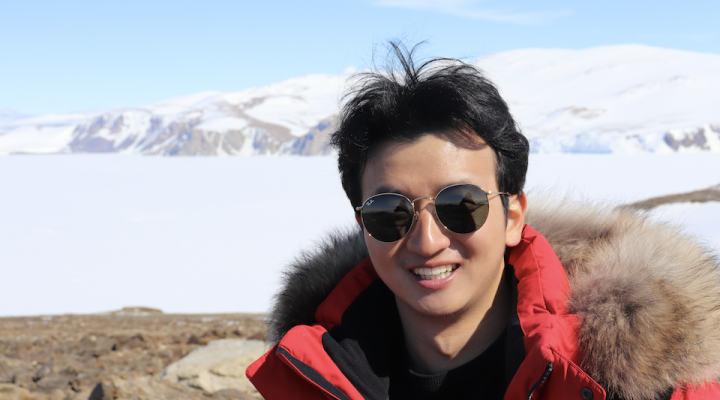If you were at the beach and wanted to know the temperature, wind speed, relative humidity, and dewpoint of the air around you, you could pull out your phone and find that information in real time with great accuracy. But if you were to get in a boat and travel just a mile or two offshore into deeper water, it would be almost impossible to find analogous data for the water column beneath the boat. To find salinity, current speed and direction, temperature, and clarity of the water even a mere 50 feet down you would need to have your own measuring equipment.
Even though water covers approximately 71% of the Earth’s surface, humans know very little about this essential part of the planet’s natural systems.
Theodoros Diamantopoulos, Ph.D. student in Cornell’s School of Civil and Environmental Engineering (CEE), is doing his part to grow what we know about what is going on beneath the surface of the Earth’s waters. Diamantopoulos works with CEE Professor Pete Diamessis to model--and better understand--a phenomenon called internal solitary waves.
Internal solitary waves are hump-shaped waves that form and move below the surface of lakes and oceans. The waves most of us are familiar with form on the surface of bodies of water, at the interface between water and the atmosphere. Internal solitary waves form at a different sort of interface.
The water in oceans and lakes is often layered, with clear delineations in density and other characteristics from layer to layer. In certain circumstances, tide or current interact with the underwater topography (called ‘bathymetry’) disturbing these layers, which can lead to the formation of internal solitary waves. An internal solitary wave propagates horizontally at the interface of layers of differing density (called ‘pycnocline’). Diamantopoulos says to picture one of these waves as large-amplitude oscillations of these layers, like the undulations of long vertically stacked vibrating strings. Each string represents a constant value of density or temperature of the water. Diamantopoulos and Diamessis can now simulate the propagation of these ‘internal tsunamis’ under realistic conditions over an actual bathymetry in the South China Sea.
Diamantopoulos grew up in Greece and earned his undergraduate and master’s degrees from the National Technical University of Athens. As an undergraduate he studied mechanical engineering and for his master’s he focused on computational mechanics. Diamantopoulos’s undergraduate thesis supervisor knew Pete Diamessis and introduced the two. They talked and it quickly became clear that Diamantopoulos’s focus on computational mechanics would fit nicely within Diamessis’s group at Cornell, where knowledge of computational fluid mechanics was essential.
Diamantopoulos, now in his sixth year at Cornell, has no regrets at all about coming to Ithaca to study internal solitary waves. Rather than squeezing into a wet suit and dropping into the ocean to study these waves, Diamantopoulos works at a computer, modelling the shoaling of an internal solitary wave over an actual bathymetry through carefully designed numerical simulations. The simulations are incredibly complex and require more computing muscle than is available in Hollister Hall. The National Science Foundation awards researchers access to high performance computing through a competitive application process for performing state-of-the-art simulations.
He describes the modelling process as a feedback loop involving a physical oceanographer, (Professor Ren-Chieh Lien from University of Washington), an applied mathematician, (Professor Kevin Lamb at Canada’s University of Waterloo), and Diamantopoulos and Diamessis at Cornell creating and running demanding simulations. “It requires a very multidisciplinary approach,” Diamantopoulos said. “First, Professor Lamb showed via numerical experiments that it is theoretically possible to have waves that demonstrate a convective instability, i.e, a heavy-over-light density configuration within the wave. And then the instrumentation and measurements of Professor Lien showed it to be true in the South China Sea! So we took the actual conditions of the bathymetry and currents and density structure measured that day and incorporated them into the next iteration of our high-accuracy flow solver. One complements the other and our simulations get better and better.”
Knowing how these waves propagate, travel, and break is not simply an intellectual exercise for Diamantopoulos and Diamessis. Internal solitary waves have been shown to play a key part in overall ocean energetics and mass transport as they start in deep waters and travel toward land they carry nutrients out of the depths and into shallower waters. Some whale species have been known to follow along behind these waves, gathering an easy meal. Particularly strong solitary waves can be hundreds of feet in amplitude and travel as fast as four knots, helping to sustain marine life and mixing heat through the oceans as they break.
On a darker note, a recent accident involving Indonesia’s KRI Nanggala submarine led to all 53 crew members dying and the sub broken into three pieces on the ocean floor. There is some evidence the sub got caught up in a strong internal solitary wave and forced far deeper than it was designed to go.
Diamantopoulos likes that his work is both fundamental and practical. His realistic simulations are allowing us to “see” a process that is otherwise generally invisible. “This multidisciplinary process--with simulations and real-world measurement complementing each other—this is how science advances,” Diamantopoulos said. “You can’t just be in your own bubble with everyone separately trying to reinvent the wheel.”
After Diamantopoulos graduates he plans to return to Greece to spend some time with his family and think about what comes next. “It feels to me like my next step is crucial, so I know I need to take some time and think about it all carefully.”





